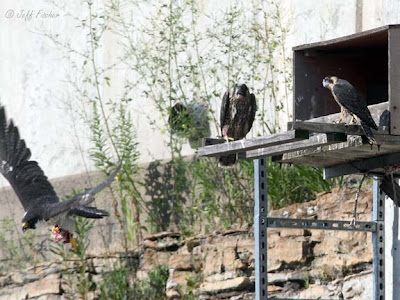Like most areas east of the Mississippi the peregrine falcon population was wiped out by DDT. DDT was a chemical insecticide that was originally used to kill mosquitoes that were spreading malaria back in the 1950's. Once Malaria was no longer a threat in the US DDT was used as an insecticide on crops. The DDT did not affect the adult birds, instead it made their egg shells very thin. So when the peregrines were incubating the eggs they would break and so there were very few birds that were being hatched. By the time DDT was banned in 1972 there were very few falcons left in the eastern half of the continent. In the 1980's the Midwest Peregrine Fund began releasing peregrine chicks that they procured from falconers in Minnesota. Initially they tried to release them in the cliff areas of the southern Mississippi River Valley. When that did not work they began to release them from sky scrapers. The release programs worked so well that the peregrine falcon was removed from the endangered species list in 1999. Here in Minnesota we actually have more nesting pair then we did prior to DDT because we created a variety of man-made nesting locations ( buildings, bridges, smoke stacks ) that increased the amount of nesting territories in the state.
One of the best nesting spots for people to actually view the young falcons is at Dam Number 1, often referred to as the Ford Dam. The nesting box is not much higher then the observation platform for the dam which gives falcon watchers a birds eye view. Today while I watched the two chicks in the nest were not very hungry so mom decided to take the food and eat it herself. Shortly later the male falcon made an error coming out of the box and he missed the perch and ended up on a ledge below. Fortunately he did not appear to be hurt. He is away from predators and the parents will keep an eye on him and feed him on the ledge but there is very little shade. Hopefully he will be flying soon and will be better off for this ittle adventure.



No comments:
Post a Comment